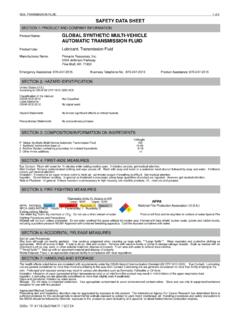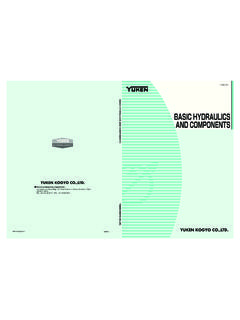Transcription of SDS: HYDRAULIC FLUID SAFETY DATA SHEET
1 SDS: HYDRAULIC FLUID 1 of 2 SAFETY data SHEETP roduct Name: PREMIUM ANTI-WEAR HD HYDRAULIC OIL ISO GRADES: 10, 15, 22, 32, 46, 68, 100 Product Use: Lubricant, HYDRAULIC Oil, ISO Grades: 10, 15, 22, 32, 46, 68, 100 Manufactures Name:Pinnacle Resources, Jefferson ParkwayPine Bluff, AR 71602 Emergency Assistance: 870-247-2315 Business Telephone No.: 870-247-2315 Product Assistance: 870-247-2315 United States ( )According to OSHA 29 CFR HCSC lassification of the mixture:OSHA HCS 2012 Not ClassifiedLabel ElementsOSHA HCS 2012No signal wordHazard StatementsNo known significant effects or critical hazardsPrecautionary StatementsNo precautionary phrases %WeightP Premium AW HD HYDRAULIC Oils, ISO 10 - 100 1001 Solvent refined, hydrotreated paraffinic distillate mineral base oil.
2 50-902 Refined and hydroprocessed heavy distillate/residual mineral oil 40-503 Additive system containing proprietary formulated ingredients 1-64 Other minor additives. <1 Eye Contact - Flush with water for 15 minutes while holding eyelids open. If irritation persists, get medical Contact -Remove contaminated clothing and wipe excess off. Wash with soap and water or a waterless hand cleaner followed by soap and water. If irritation occurs, get medical - If overcome by vapor remove victim to fresh air; administer oxygen if breathing is difficult. Get medical - Do not induce vomiting.
3 In general no treatment is necessary unless large quantities of product are ingested. However, get medical to Physician - In general, Emesis Induction is unnecessary in high viscosity, low volatility products, , most oils and greases. Flammable limits /% Volume in AiR Lower: N/AV Upper: N/AV NFPANFPA RATINGS- Health: 1 Flammability: 1 Reactivity: 0 Special: -- National Fire Protection Association ( ) 00 NPCA-HMIS RATINGS- Health: 1 Flammability: 1 Reactivity: 0 1 Extinguishing Media: Use water fog, foam, dry chemical or CO2.
4 Do not use a direct stream of water. Product will float and be reignited on surface of Fire Fighting Procedures and Precautions:Material will not burn unless preheated. Do not enter confined fire-space without full bunker gear (Helmet with face shield, bunker coats, gloves and rubber boots), including a positive-pressure NIOSH-Approved self-contained breathing apparatus. Cool fire exposed containers with or Leak Procedures:May burn although not readily ignitable. Use cautious judgement when cleaning up large spills. **Large Spills** Wear respirator and protective clothing as appropriate. Shut off source of leak. If safe to do so, dike and contain.
5 Remove with vacuum trucks or pump to storage salvage vessels. Soak up residue with an absorbent such as clay, sand, or other suitable materials; dispose of properly. Flush area with water to remove trace residue.**Small Spills** Take up with an absorbent material and dispose of Disposal: Place in an appropriate disposal facility in compliance with local health effects noted below are consistent with requirements under the OSHA Hazard Communication Standard (29 CFR ). Eye Contact: Lubricating oils are general considered no more than minimally irritating to the Contact: Lubricating oils are generally considered no more than mildly irritating to the skin. Prolonged and repeated contact may result in various skin disorders such as Dermatitis, Folliculitis or Oil : Inhalation of vapor (generated at high temperatures only) or oil mist from this product may result in mild irritation of the upper respiratory : Lubricating oils are generally considered no more than slightly toxic if and symptoms: Irritation as noted : Do not store in unlabeled containers.
6 Use appropriate containment to avoid environmental contamination. Store and use only in equipment/containers designed for use with this productAggravated Medical Conditions:SECTION 1: PRODUCT AND COMPANY INFORMATIONSECTION 2: HAZARD IDENTIFICATIONSECTION 3: COMPOSITION/INFORMATION ON INGREDIENTSSECTION 4: FIRST-AIDE MEASURESSECTION 5: FIRE FIGHTING MEASURESSECTION 6: ACCIDENTAL RELEASE MEASURESSECTION 7: HANDLING AND STORAGESDSn: 0 -SDS: HYDRAULIC FLUID 1 of 2 Preexisting skin and respiratory disorders may be aggravated by exposure to this product.
7 The International Agency For Cancer Research has determined there is sufficient evidence for the carcinogenicity in experimental animals exposed by contact to used motor (crankcase) oil. Handling procedures and SAFETY precautions in the MSDS should be followed to minimize exposure to the product as used lubricating oil in gasoline or diesel fueled internal combustion skin contact. Wash with soap and water before eating, drinking, smoking or using toilet facilities. Launder contaminated clothing before reuse, properly dispose of contaminated leather articles, including shoes that cannot be decontaminated. Store in a cool, dry place with adequate ventilation. Keep away from open flames and high Protection:If exposure may or does exceed occupational exposure limits (SECTION 2) use a NIOSH-Approved respirator to prevent overexposure.
8 In accord with 29 CFR use either an atmosphere-supplying respirator or an air-purifying respirator for organic vapors and clothing:Wear chemical resistant gloves and other protective clothing as required to minimize skin contact. Wear SAFETY goggles to avoid eye contact. Test data from published literature and/or glove and clothing manufacturers indicate the best protection is provided by nitrile Exposure Limits (estimated 8-hour workday): OSHA Z1 ACGIH OTHERS tandards -> PEL/TWA PEL/CEILING TLV/TWA TLV/STEL Oil Mist - > 5 Mg/M3* None 5Mg/M3* 10 Mg/M3* None (*Oil Mist, Mineral)Physical State: Liquid Auto Ignition Temperature: >320 C/608 F Upper/Lower Explosion/Flammability limits.
9 1-10 %V(based on Mineral Oil) Boiling Point: NA Gravity,(H2O= ) API @ 60 F: to Melt Point: NA Pour Point: -35 F to 0 F Flash Pt., COC: 370 F to 450 FEvaporation Rate: NA Percent Volatile by Volume: Negligible Vapor Density: (Air= ) > Viscosity@100 C, cSt.: - Solubility In Water: Negligible Appearance: Clear-yellow to darker Odor: Mild Hydrocarbon Viscosity@ 40 C, cSt.: - 100 PH: NA Vapor Pressure: < ( @ 20 C [Est]) Electrical Conductivity: Not expected to be a static : Stable Hazardous Polymerization: Will Not Occur Conditions and Materials to Avoid: Avoid heat, open flames and oxidizing Decomposition Products:Thermal decomposition products are highly dependent on the combustion conditions.
10 A complex mixture of airborne solid, liquid, particulate and gases will evolve when this material undergoes pyrolysis or combustion. Carbon monoxide and other unidentified organic compounds may be formed upon LD50> g/kg (Rabbit)OSHA - Non ToxicBased on similar material(s)Oral LD50> g/kg (Rat)OSHA - Non ToxicBased on similar material(s)Carcinogenicity Classification (Highly Refined Mineral Oil/IP346<3%):IARC 3=No carcinogenicity to A4=Unclassified as a human carcinogenicity classification. NTP=No IOSHA=NoThis product is classified as an oil under section 311 of the Clean Water Act. Spills entering (A) surface waters of (B) any water courses or sewer s-entering/leading to surface waters that cause a sheen must be reported to the nearest local Environmental Protection Agency is suitable for burning in an enclosed, controlled burner for fuel value or disposal by supervised incineration.




